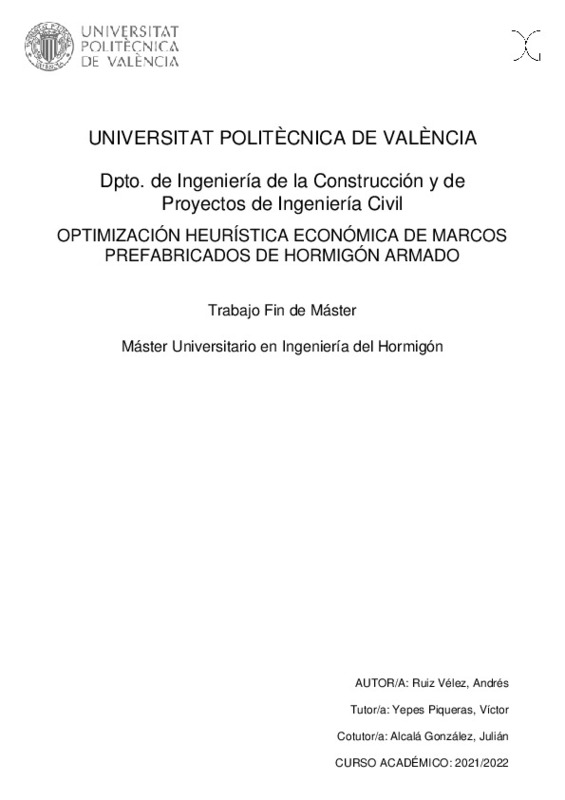|
Resumen:
|
[ES] Tradicionalmente, el diseño de estructuras se ha fundamentado en los conocimientos, habilidad y experiencia del ingeniero responsable, algo que da lugar a diseños estructuralmente seguros, pero que no hacen un uso ...[+]
[ES] Tradicionalmente, el diseño de estructuras se ha fundamentado en los conocimientos, habilidad y experiencia del ingeniero responsable, algo que da lugar a diseños estructuralmente seguros, pero que no hacen un uso óptimo de los materiales. Fundamentado en la necesidad de mejorar el proceso de diseño, el presente estudio busca diseños más sostenibles mediante la optimización de los recursos consumidos en una de las estructuras con un uso más extendido en la infraestructura de transporte. En este contexto, se lleva a cabo la optimización económica de un marco prefabricado de hormigón armado mediante tres técnicas heurísticas. El trabajo comprende el estudio del estado del arte, modelado matemático, y el desarrollo y posterior aplicación de software propio de cálculo, verificación y optimización estructural. Los resultados muestran diseños no tradicionales con secciones de canto reducido y bajo coste, que validan la aplicación del software desarrollado. La posibilidad de configurar diversas tipologías estructurales, en conjunto con la consideración simultánea de varias funciones objetivo hace del software desarrollado una potente herramienta de optimización multiobjetivo que permitirá avances en investigaciones posteriores.
[-]
[EN] Traditionally, structural design has been conditioned by the responsible engineer¿s knowledge, technical skills and previous experiences. This results in structurally safe designs which do not optimize resource ...[+]
[EN] Traditionally, structural design has been conditioned by the responsible engineer¿s knowledge, technical skills and previous experiences. This results in structurally safe designs which do not optimize resource consumption. Based on the need to improve the design process, the present study seeks more sustainable designs by optimizing the resources consumed during the fabrication of one of the common structures in the transportation infrastructure. In this context, the economic optimization of precast reinforced concrete frames is carried out using three heuristic techniques. The work comprises the study of the state of the art, mathematical modelling, and development and subsequent application of proprietary structural calculation, verification and optimization software. The results show non-traditional designs with reduced depth sections and low cost, validating the application of the developed software. The possibility of configuring different structural typologies, together with the simultaneous consideration of several objective functions, show that the developed software is a powerful multiobjective optimization tool that will allow advances in further research.
[-]
|







